Jacob Whitehill
The CHASM-SWPC Dataset for Coronal Hole Detection & Analysis
Nov 18, 2025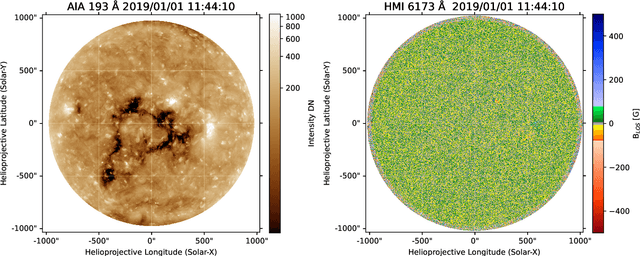
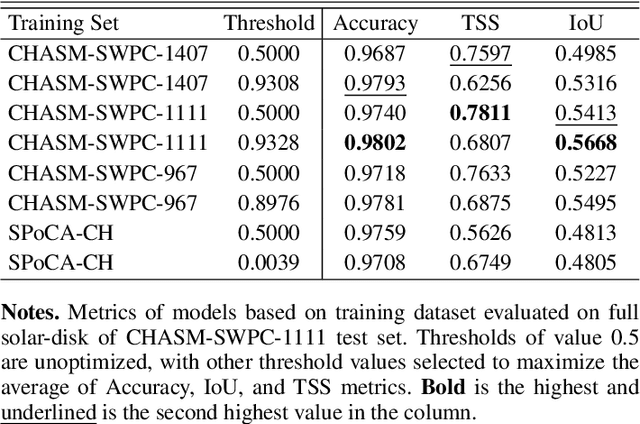

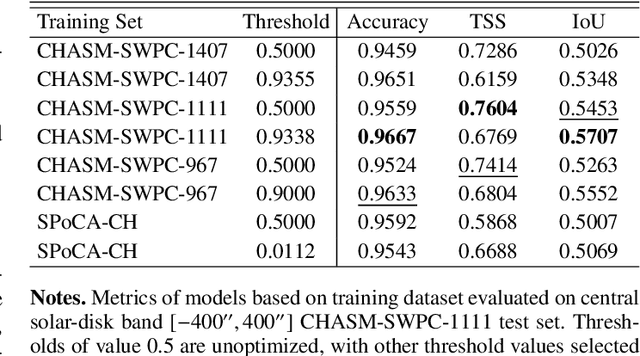
Abstract:Coronal holes (CHs) are low-activity, low-density solar coronal regions with open magnetic field lines (Cranmer 2009). In the extreme ultraviolet (EUV) spectrum, CHs appear as dark patches. Using daily hand-drawn maps from the Space Weather Prediction Center (SWPC), we developed a semi-automated pipeline to digitize the SWPC maps into binary segmentation masks. The resulting masks constitute the CHASM-SWPC dataset, a high-quality dataset to train and test automated CH detection models, which is released with this paper. We developed CHASM (Coronal Hole Annotation using Semi-automatic Methods), a software tool for semi-automatic annotation that enables users to rapidly and accurately annotate SWPC maps. The CHASM tool enabled us to annotate 1,111 CH masks, comprising the CHASM-SWPC-1111 dataset. We then trained multiple CHRONNOS (Coronal Hole RecOgnition Neural Network Over multi-Spectral-data) architecture (Jarolim et al. 2021) neural networks using the CHASM-SWPC dataset and compared their performance. Training the CHRONNOS neural network on these data achieved an accuracy of 0.9805, a True Skill Statistic (TSS) of 0.6807, and an intersection-over-union (IoU) of 0.5668, which is higher than the original pretrained CHRONNOS model Jarolim et al. (2021) achieved an accuracy of 0.9708, a TSS of 0.6749, and an IoU of 0.4805, when evaluated on the CHASM-SWPC-1111 test set.
Improving Named Entity Transcription with Contextual LLM-based Revision
Jun 12, 2025Abstract:With recent advances in modeling and the increasing amount of supervised training data, automatic speech recognition (ASR) systems have achieved remarkable performance on general speech. However, the word error rate (WER) of state-of-the-art ASR remains high for named entities. Since named entities are often the most critical keywords, misrecognizing them can affect all downstream applications, especially when the ASR system functions as the front end of a complex system. In this paper, we introduce a large language model (LLM) revision mechanism to revise incorrect named entities in ASR predictions by leveraging the LLM's reasoning ability as well as local context (e.g., lecture notes) containing a set of correct named entities. Finally, we introduce the NER-MIT-OpenCourseWare dataset, containing 45 hours of data from MIT courses for development and testing. On this dataset, our proposed technique achieves up to 30\% relative WER reduction for named entities.
Survey of End-to-End Multi-Speaker Automatic Speech Recognition for Monaural Audio
May 16, 2025Abstract:Monaural multi-speaker automatic speech recognition (ASR) remains challenging due to data scarcity and the intrinsic difficulty of recognizing and attributing words to individual speakers, particularly in overlapping speech. Recent advances have driven the shift from cascade systems to end-to-end (E2E) architectures, which reduce error propagation and better exploit the synergy between speech content and speaker identity. Despite rapid progress in E2E multi-speaker ASR, the field lacks a comprehensive review of recent developments. This survey provides a systematic taxonomy of E2E neural approaches for multi-speaker ASR, highlighting recent advances and comparative analysis. Specifically, we analyze: (1) architectural paradigms (SIMO vs.~SISO) for pre-segmented audio, analyzing their distinct characteristics and trade-offs; (2) recent architectural and algorithmic improvements based on these two paradigms; (3) extensions to long-form speech, including segmentation strategy and speaker-consistent hypothesis stitching. Further, we (4) evaluate and compare methods across standard benchmarks. We conclude with a discussion of open challenges and future research directions towards building robust and scalable multi-speaker ASR.
Multi-modal Speech Transformer Decoders: When Do Multiple Modalities Improve Accuracy?
Sep 13, 2024Abstract:Decoder-only discrete-token language models have recently achieved significant success in automatic speech recognition. However, systematic analyses of how different modalities impact performance in specific scenarios remain limited. In this paper, we investigate the effects of multiple modalities on recognition accuracy on both synthetic and real-world datasets. Our experiments suggest that: (1) Integrating more modalities can increase accuracy; in particular, our paper is, to our best knowledge, the first to show the benefit of combining audio, image context, and lip information; (2) Images as a supplementary modality for speech recognition provide the greatest benefit at moderate noise levels, moreover, they exhibit a different trend compared to inherently synchronized modalities like lip movements; (3) Performance improves on both synthetic and real-world datasets when the most relevant visual information is filtered as a preprocessing step.
Discrete Multimodal Transformers with a Pretrained Large Language Model for Mixed-Supervision Speech Processing
Jun 04, 2024Abstract:Recent work on discrete speech tokenization has paved the way for models that can seamlessly perform multiple tasks across modalities, e.g., speech recognition, text to speech, speech to speech translation. Moreover, large language models (LLMs) pretrained from vast text corpora contain rich linguistic information that can improve accuracy in a variety of tasks. In this paper, we present a decoder-only Discrete Multimodal Language Model (DMLM), which can be flexibly applied to multiple tasks (ASR, T2S, S2TT, etc.) and modalities (text, speech, vision). We explore several critical aspects of discrete multi-modal models, including the loss function, weight initialization, mixed training supervision, and codebook. Our results show that DMLM benefits significantly, across multiple tasks and datasets, from a combination of supervised and unsupervised training. Moreover, for ASR, it benefits from initializing DMLM from a pretrained LLM, and from a codebook derived from Whisper activations.
Automated Evaluation of Classroom Instructional Support with LLMs and BoWs: Connecting Global Predictions to Specific Feedback
Oct 02, 2023



Abstract:With the aim to provide teachers with more specific, frequent, and actionable feedback about their teaching, we explore how Large Language Models (LLMs) can be used to estimate ``Instructional Support'' domain scores of the CLassroom Assessment Scoring System (CLASS), a widely used observation protocol. We design a machine learning architecture that uses either zero-shot prompting of Meta's Llama2, and/or a classic Bag of Words (BoW) model, to classify individual utterances of teachers' speech (transcribed automatically using OpenAI's Whisper) for the presence of 11 behavioral indicators of Instructional Support. Then, these utterance-level judgments are aggregated over an entire 15-min observation session to estimate a global CLASS score. Experiments on two CLASS-coded datasets of toddler and pre-kindergarten classrooms indicate that (1) automatic CLASS Instructional Support estimation accuracy using the proposed method (Pearson $R$ up to $0.46$) approaches human inter-rater reliability (up to $R=0.55$); (2) LLMs yield slightly greater accuracy than BoW for this task; and (3) the best models often combined features extracted from both LLM and BoW. Finally, (4) we illustrate how the model's outputs can be visualized at the utterance level to provide teachers with explainable feedback on which utterances were most positively or negatively correlated with specific CLASS dimensions.
Compositional Affinity Propagation: When Clusters Have Compositional Structure
Sep 09, 2021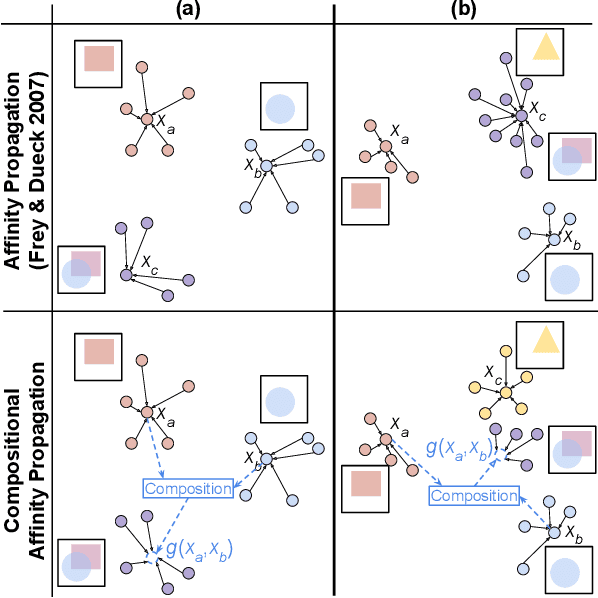
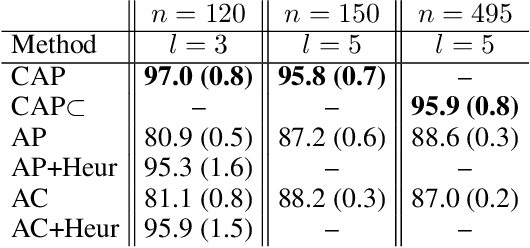
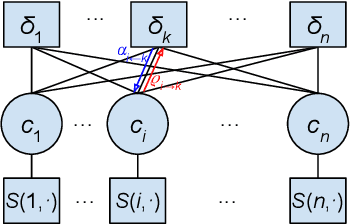
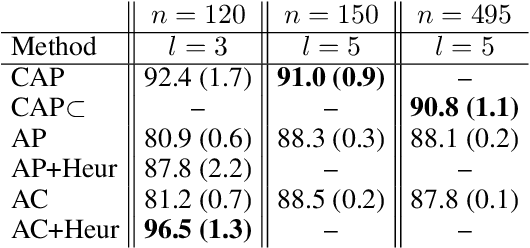
Abstract:We consider a new kind of clustering problem in which clusters need not be independent of each other, but rather can have compositional relationships with other clusters (e.g., an image set consists of rectangles, circles, as well as combinations of rectangles and circles). This task is motivated by recent work in few-shot learning on compositional embedding models that structure the embedding space to distinguish the label sets, not just the individual labels, assigned to the examples. To tackle this clustering problem, we propose a new algorithm called Compositional Affinity Propagation (CAP). In contrast to standard Affinity Propagation as well as other algorithms for multi-view and hierarchical clustering, CAP can deduce compositionality among clusters automatically. We show promising results, compared to several existing clustering algorithms, on the MultiMNIST, OmniGlot, and LibriSpeech datasets. Our work has applications to multi-object image recognition and speaker diarization with simultaneous speech from multiple speakers.
Harnessing Geometric Constraints from Auxiliary Labels to Improve Embedding Functions for One-Shot Learning
Mar 05, 2021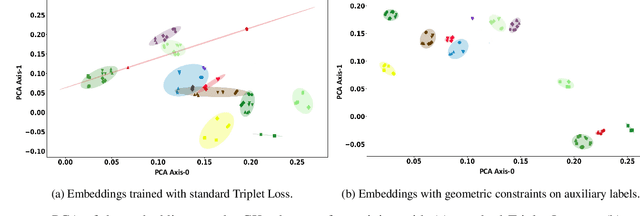
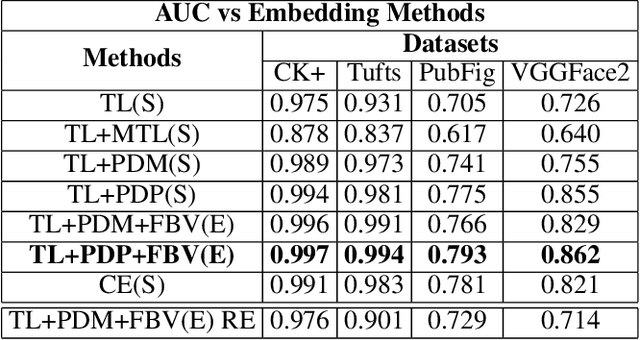

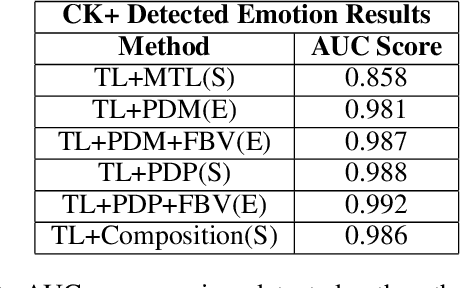
Abstract:We explore the utility of harnessing auxiliary labels (e.g., facial expression) to impose geometric structure when training embedding models for one-shot learning (e.g., for face verification). We introduce novel geometric constraints on the embedding space learned by a deep model using either manually annotated or automatically detected auxiliary labels. We contrast their performances (AUC) on four different face datasets(CK+, VGGFace-2, Tufts Face, and PubFig). Due to the additional structure encoded in the embedding space, our methods provide a higher verification accuracy (99.7, 86.2, 99.4, and 79.3% with our proposed TL+PDP+FBV loss, versus 97.5, 72.6, 93.1, and 70.5% using a standard Triplet Loss on the four datasets, respectively). Our method is implemented purely in terms of the loss function. It does not require any changes to the backbone of the embedding functions.
Compositional embedding models for speaker identification and diarization with simultaneous speech from 2+ speakers
Oct 22, 2020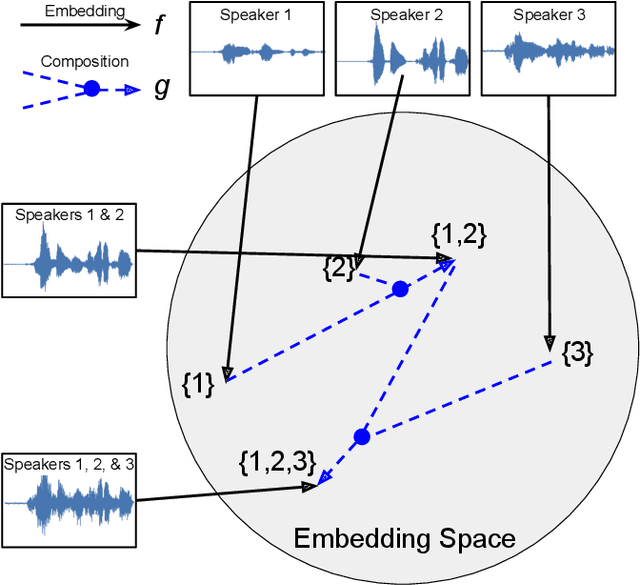
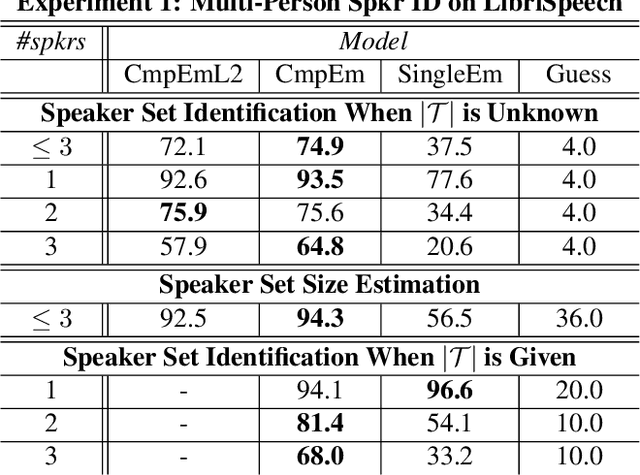

Abstract:We propose a new method for speaker diarization that can handle overlapping speech with 2+ people. Our method is based on compositional embeddings [1]: Like standard speaker embedding methods such as x-vector [2], compositional embedding models contain a function f that separates speech from different speakers. In addition, they include a composition function g to compute set-union operations in the embedding space so as to infer the set of speakers within the input audio. In an experiment on multi-person speaker identification using synthesized LibriSpeech data, the proposed method outperforms traditional embedding methods that are only trained to separate single speakers (not speaker sets). In a speaker diarization experiment on the AMI Headset Mix corpus, we achieve state-of-the-art accuracy (DER=22.93%), slightly higher than the previous best result (23.82% from [3]).
Toward Automated Classroom Observation: Multimodal Machine Learning to Estimate CLASS Positive Climate and Negative Climate
May 19, 2020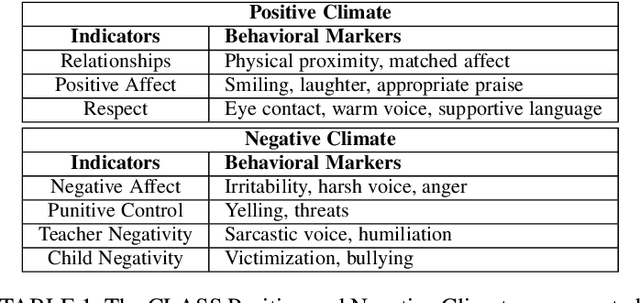
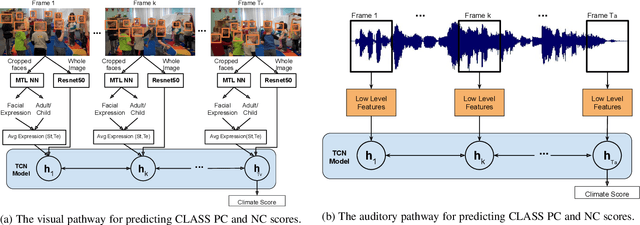

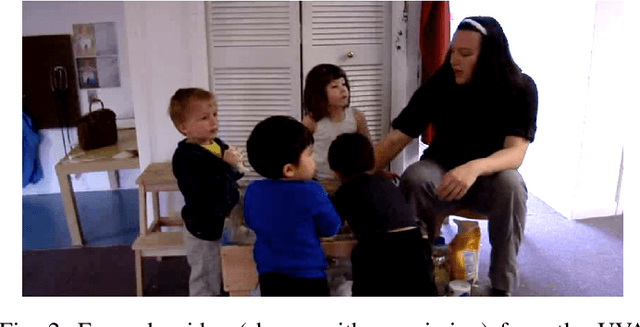
Abstract:In this work we present a multi-modal machine learning-based system, which we call ACORN, to analyze videos of school classrooms for the Positive Climate (PC) and Negative Climate (NC) dimensions of the CLASS observation protocol that is widely used in educational research. ACORN uses convolutional neural networks to analyze spectral audio features, the faces of teachers and students, and the pixels of each image frame, and then integrates this information over time using Temporal Convolutional Networks. The audiovisual ACORN's PC and NC predictions have Pearson correlations of $0.55$ and $0.63$ with ground-truth scores provided by expert CLASS coders on the UVA Toddler dataset (cross-validation on $n=300$ 15-min video segments), and a purely auditory ACORN predicts PC and NC with correlations of $0.36$ and $0.41$ on the MET dataset (test set of $n=2000$ videos segments). These numbers are similar to inter-coder reliability of human coders. Finally, using Graph Convolutional Networks we make early strides (AUC=$0.70$) toward predicting the specific moments (45-90sec clips) when the PC is particularly weak/strong. Our findings inform the design of automatic classroom observation and also more general video activity recognition and summary recognition systems.
 Add to Chrome
Add to Chrome Add to Firefox
Add to Firefox Add to Edge
Add to Edge